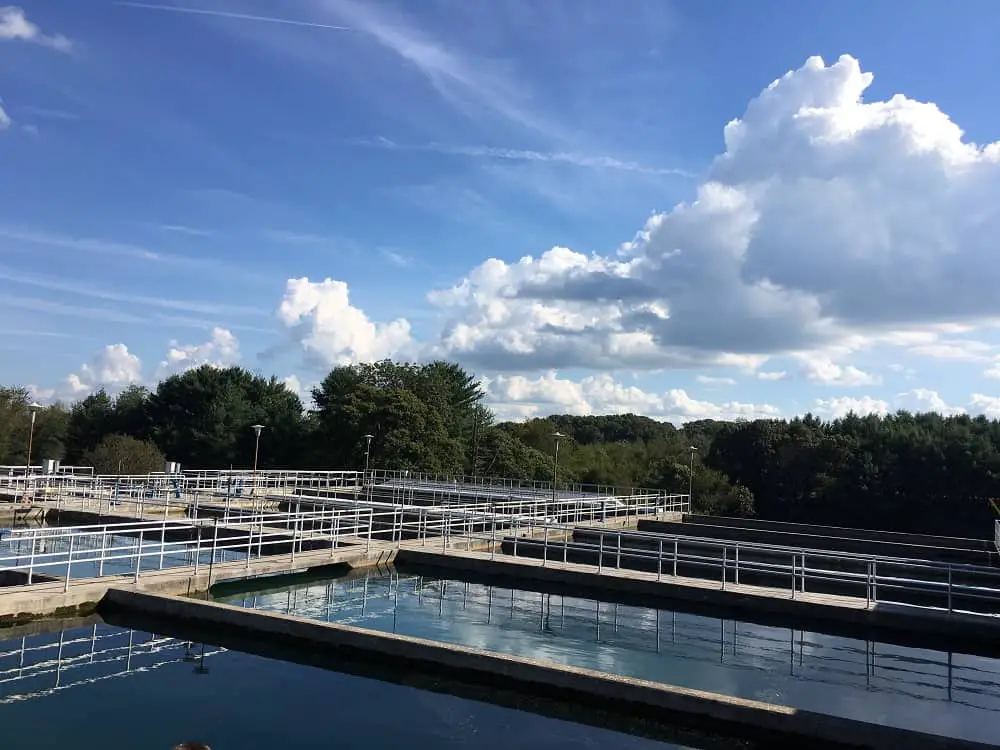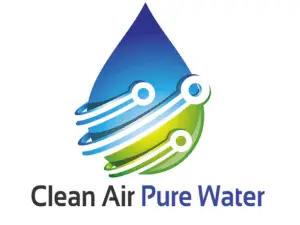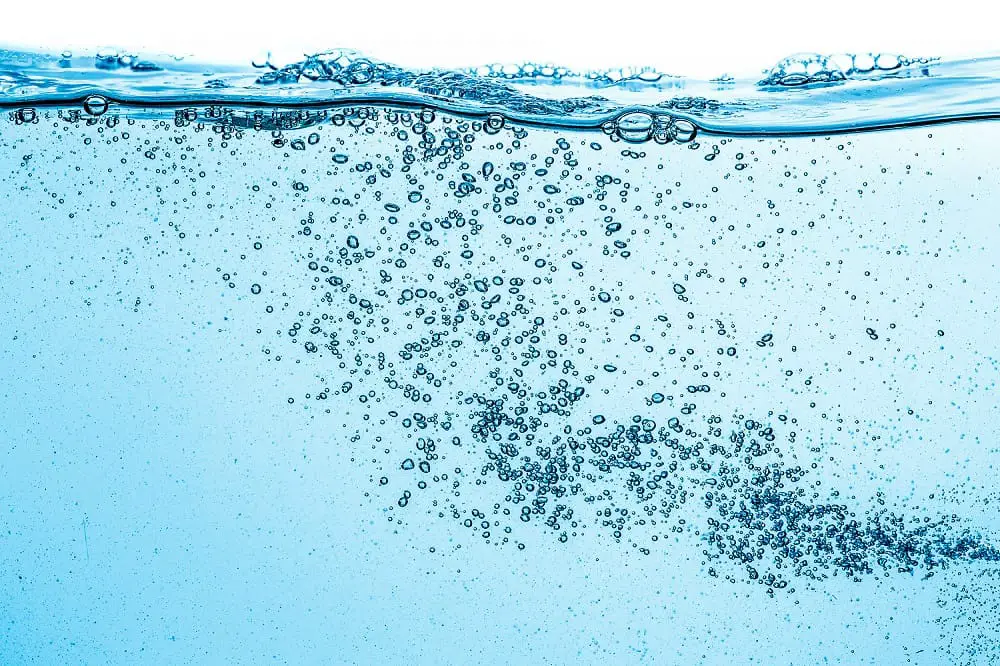Chlorine is found in tap water distributed by most U.S. and many European water treatment facilities. People who have aquariums or simply don’t want to be exposed to chlorine in drinking water often look for ways to remove it. It will kill fish and is a toxic chemical.
Letting water sit does remove chlorine. Chlorine is a gas that will evaporate from standing water if the air is warm enough. Some refer to this as letting water breathe. Although there are different opinions on how long this takes, some chlorine will evaporate from water exposed to air.
Next will be information about chlorine, how to know if it’s in your water, and why it’s in your water. Opinions on how effective letting water sit works to remove chlorine are included. Also discussed are more certain ways of removing chlorine, and the pros and cons of alternative methods of disinfecting drinking water.
What Is Chlorine?
Chlorine is a halogen, which means it produces a salt, along with other halogens, bromine, iodine, fluorine, and astatine. When chlorine reacts with sodium, table salt is produced.
According to the Centers for Disease Control and Prevention (CDC), chlorination, “adding chlorine to drinking water” as a means of disinfecting, can be done in different ways. You can use chlorine as a “compressed elemental gas, sodium hypochlorite solution (NaOCl) or solid calcium hypochlorite (Ca(OCl).”
Most municipalities add the chlorine as a gas, adds chemist Robert L. Wolke. However, when the chlorine’s forms are mixed with water, hypochlorous acid (HOCl) is produced, which does the disinfecting.
At high concentrations, chlorine “is a choking, toxic gas that would burn your lungs and kill you in fairly short order, if you were unable to get away,” says chemist Theodore Gray, while the CDC claims it “could be harmful in high doses,” but not when it’s mixed in drinking water.
How Does Chlorine Get Into Our Water?
Water departments in most U.S. cities add some form of chlorine to water supplies they treat for household use. When water customers turn on the tap or shower, the water that pours out contains allowable levels of free chlorine, or, in some cases, chloramine, which is a combination of chlorine and ammonia.
However, a few water treatment facilities in the U.S. and several in Europe use chlorine combined with ozone treatment and other treatments.
Why Is Chlorine in Our Water?
Chlorine kills bacteria and other pathogens that cause diseases such as protozoans and viruses, including COVID-19. EPA provides a factsheet and table with a laundry list of infectious agents found in domestic wastewater. These include 17 agents in four categories: bacteria, helminths, protozoa, and viruses.
According to the Centers for Disease Control (CDC), “Sodium hypochlorite, the active ingredient in common household bleach, is the primary disinfectant promoted by CDC and the World Health Organization.”
Other forms of equally effective chlorine-containing compounds, available in tablet or granular form, are also used. Although there are other ways to disinfect water, they are as cost-effective or considered as equally effective as chlorine by themselves.
Do All Water Departments Add Chlorine to Water?
Very few water facilities do not use chlorine as their primary means of disinfecting. However, there has been a trend toward using ozone for some time, with over 45 U.S. treatment plants having installed ozone systems as of 1991.
According to the CDC, “Some water systems that use water from a groundwater source like community wells, do not have to add a disinfectant at all.” So, before you bother with trying to remove chlorine from your water, make sure it’s in there in the first place. You can find out what’s in your water by requesting a copy of its Consumer Confidence Report from your water department.

Why Does Anyone Want to Remove Chlorine From Water?
As stated above, chlorine is a toxic chemical that can kill fish, even when diluted in water. It cannot be in the water used for dialysis without causing possible serious harm to the patient. Due to genetic polymorphisms, there is a difference among individual abilities to handle or detoxify toxic exposures. Some may want or need to reduce their toxic load and remove chlorine and other chemicals from the water they drink.
For use in aquariums, letting the chlorine evaporate by sitting out could make it safe enough for fish. However, this process does not decontaminate the water enough for use in dialysis.
If Chlorine Is Toxic, Why Do Water Departments Use It?
Facilities that use chlorine to make it potable believe the benefits outweigh the risks. But the use of chlorine over other methods is mainly about costs. Chlorination is cheap and effective. However, it is not the most effective or safest water supply treatment method.
Even though less-toxic methods of disinfecting water are available, some are even more effective than chlorine or chloramine. These are usually more expensive and may need to be supplemented with another disinfectant in the distribution process.
Many municipalities and consumers can not or will not pay the extra costs it takes to change how most water treatment facilities currently operate.
What Are the Pros and Cons of the Different Disinfecting Methods Used?
EPA provides an online pamphlet discussing “Emerging Technologies for Wastewater Treatment,” which provides a rather technical discussion on the pros and cons of newer disinfectants being used. One of these is peracetic acid or peroxyacetic acid (PAA), which EPA says is stronger than chlorine “but not as strong as ozone.”
Another source provides information on the pros and cons of using ozone vs. chlorine. The search for alternatives for chlorine has to do with chlorine’s habit of forming disinfection byproducts (DBPs) like trihalomethanes and haloacetic acids, which are carcinogenic.
The EPA now requires public water facilities to give customers special notice when these levels are too high.
How Effective Is Letting Water Sit to Remove Chlorine?
This method can remove most of the free chlorine from the water, but the time it takes to do so is dependent upon several factors, Chemist Robert L. Wolke explains.
“The problem is that the effectiveness of letting the chlorine dissipate depends on many variables, including the water’s temperature, its acidity or pH, your olfactory sensitivity, the size and shape of the container, the amount of exposed water surface and, of course, its chlorine content. This can vary substantially from one municipality to another or within each municipality, depending on the system’s demand level and how far down the pipeline you live.”
Wolke adds that counting on the water being safe enough for your aquarium fish, however, is “a hit-or-miss proposition.” The point is, if you want to be sure the water is chlorine-free, you may want to boil it or filter it after allowing it to sit for good measure.
What Is the Most Effective Way to Remove Chlorine From Tap Water?
Most, if not all, sources agree that the best way to remove all the bad stuff, including chlorine from tap water, is to use reverse osmosis (RO).
If you have concerns about chlorine, trihalomethanes, cryptosporidium, fluoride, and other contaminants found in drinking water, invest in a good RO system, such as this Waterdrop RO Reverse Osmosis Drinking Water Filtration System. This is certified by the National Sanitation Foundation.
Final Thoughts
Even though you can remove some or most of the free chlorine from tap water by allowing it to sit uncovered, this will not eliminate many other contaminants in the water. It may also not remove enough chlorine to make the water safe for aquarium use and not be suitable for dialysis.
The City of Greensboro, N.C. Water Department recommends you refrigerate unused water after allowing it to sit out for no more than 24 hours because once the chloride has dissipated, the water has lost its disinfecting capability.
You may want to put the water in sunlight or boil it to speed up the removal process, but keep in mind that boiling tap water concentrates any fluoride added to it instead of removing that particular toxic ingredient. Chloramine, used by some water departments, will not dissipate if you let the water sit.
Sources
- EPA: Coronavirus: Is Drinking Tap Water Safe?
- World Health Organization: Water Sanitation, Hygiene, and Health
- EPA: Wastewater Technology Factsheet
- EPA: Ozone Disinfection
- CDC: Disinfecting with Chlorine and Chloramine
- Science Direct: Genetic Polymorphism
- Chemistry for the Protection of the Environment: Current Status of Ozone for Municipal Wastewater Treatment In the United States
- CDC: How Do I Find Out What’s in My Drinking Water?
- CDC: Consumer Confidence Reports
- EPA: Emerging Technologies for Wastewater Treatment
- EPA: Trihalomethanes
- EPA: Notice of High Levels of Trihalomethanes
- New Hampshire Department of Environmental Services: Environmental Fact Sheet: Haloacetic Acids (five) (HAA5): Health Information Summary
- Drinking-Water and Health: Disinfecting Methods and Efficacy
- Washington Post: Chlorine Confusion
- Wikipedia: National Sanitation Foundation
- CDC: Cryptosporidium

